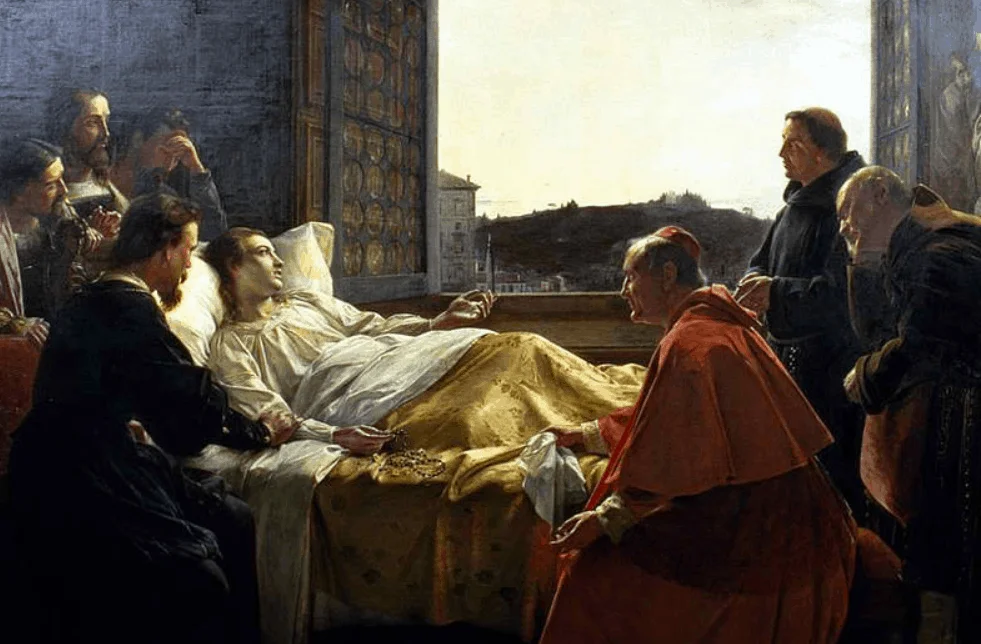Raffaello Sanzio da Urbino, better known as simply Raphael, was one of the most prolific and talented artists of the High Renaissance. He created one masterpiece after the other, mostly commissioned by Pope Julius II who also engaged the other two famous artists at the time, Leonardo da Vinci and Michelangelo.
Some of his most famous works of art are frescos located at the Apostolic Palace in Vatican City and are referred to as the “Raphael Rooms” or “Stanze.” His most famous works include “The School of Athens,” “Disputation of the Holy Sacrament,” “The Sistine Madonna,” and “Transfiguration.”
How did Raphael die?
So how did Raphael die at the young age of 37 while being surrounded by the best doctors in Rome at the time?

At the end of March of the year 1520, Raphael got struck with a severe fever. Unable to treat and cure the disease effectively, he was pronounced dead one or two weeks later (accounts of how long he lay bedridden vary) on April 6, 1520.
The famous Italian historian Giorgio Vasari, who wrote a detailed account of the final weeks of the famous artist, claimed that Raphael’s turbulent affair and excessive sex life with Margherita Luti, better known as “La Fornarina” or “The Baker’s Daughter,” was the cause of his demise.

This led to the rumor being spread that he had contracted a sexually transmitted disease such as Gonorrhea. However, scientists claim that this can’t be true as the incubation period of just 2 weeks after that final night of passion is simply too short.
Vasari had written that he was suddenly struck with a violent fever, so scientists of the University of Milan-Bicocca concluded that he must have had pneumonia.
“He didn’t suffer from an intestinal disease and for this reason, we hypothesized pneumonia,” Michele Augusto Riva, one of the study’s authors and a researcher of the history of medicine at the University of Milan-Bicocca claims.
One of the most remarkable facts about his illness is that he was still doing pretty well initially. He was able to dictate his will was to ensure his mistress would have enough funds and his work would be turned over to his studio.

This leads scientists to conclude that something else might have caused his illness to become worse, most probably by his condition being misdiagnosed.
We know that Raphael failed to mention the numerous doctors who were by his side about his passionate affair, along with the fact that he sneaked back from his house in the middle of the night.
If he had mentioned that he just had passionate sex a few nights earlier followed by an evening walk through the cold streets of Rome in light clothes (after all, it was March and Rome must have been enjoyable in the daytime but pretty cold at night back then) while still sweating like a pig, the doctors might have come to another diagnosis.
Instead, they seemed to have used an alternative method very popular back then in order to “cure” the overheated Raphael. Instead of simply cooling the patient down, they used bloodletting to solve the problem of “imbalance” in his body.
Vasari wrote that things went pretty much downhill instantly after this procedure was started as “he was weakened and felt himself sinking, for he was in need rather of restoratives.”

Did they simply misdiagnose Raphael’s disease because he failed to mention what probably caused it? It certainly appears to be this way because doctors were pretty much aware that bloodletting was dangerous for a patient suffering from an infectious disease.
If they had known the source of his violent fever, they most certainly wouldn’t have used bloodletting as a treatment, and Raphael might have lived for another 50 years and have countless more masterpieces, just as his main rival, Michelangelo, who passed away in his late 80’s.
Instead, we are commemorating the 500th anniversary of his death this year, and each day of this year, a red rose will be placed on his tomb in the Pantheon in Rome which reads:
Here lies Raphael, by whom Nature herself feared to be outdone while he lived, and when he died, feared that she herself would die.
Quote commemorating the 500th anniversary of Raphael’s death.

